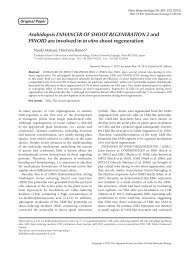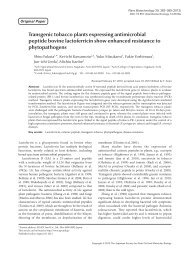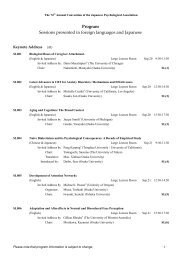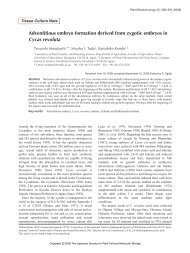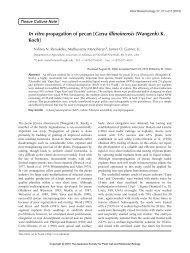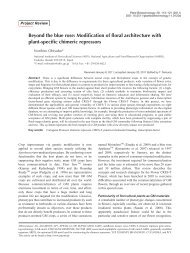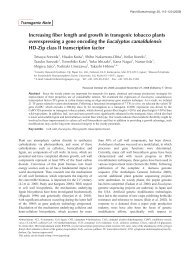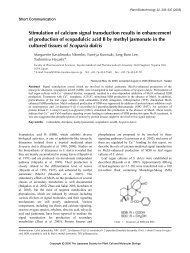Plant Biotechnol. 28(2): 131-140 (2011) - Wdc-jp.biz
Plant Biotechnol. 28(2): 131-140 (2011) - Wdc-jp.biz
Plant Biotechnol. 28(2): 131-140 (2011) - Wdc-jp.biz
Create successful ePaper yourself
Turn your PDF publications into a flip-book with our unique Google optimized e-Paper software.
<strong>Plant</strong> <strong>Biotechnol</strong>ogy <strong>28</strong>, <strong>131</strong>–<strong>140</strong> (<strong>2011</strong>)<br />
DOI: 10.5511/plantbiotechnology.11.0121a<br />
Original Paper<br />
Arabidopsis chimeric TCP3 repressor produces novel floral traits<br />
in Torenia fournieri and Chrysanthemum morifolium<br />
Takako Narumi 1,a , Ryutaro Aida 1 , Tomotsugu Koyama 2,3 , Hiroyasu Yamaguchi 1 ,<br />
Katsutomo Sasaki 1 , Masahito Shikata 1 , Masayoshi Nakayama 1 ,<br />
Masaru Ohme-Takagi 2 , Norihiro Ohtsubo 1, *<br />
1 National Institute of Floricultural Science, Tsukuba, Ibaraki 305-8519, Japan; 2 Bioproduction Research Institute,<br />
National Institute of Advanced Industrial Science and Technology (AIST), Tsukuba, Ibaraki 305-8562, Japan; 3<br />
Graduate School of Biostudies, Kyoto University, Kyoto 606-8502, Japan<br />
* E-mail: nohtsubo@affrc.go.<strong>jp</strong> Tel & FAX: 81-29-838-6822<br />
Received December 24, 2010; accepted January 21, <strong>2011</strong> (Edited by Y. Tanaka)<br />
Abstract Chimeric REpressor gene-Silencing Technology (CRES-T) is a powerful gene-silencing tool to analyze the<br />
function of Arabidopsis transcription factors. To investigate whether CRES-T is also applicable to horticultural plants<br />
inadequate for genetic engineering because of their limited molecular biological characterization and polyploidy, we applied<br />
CRES-T to torenia and the hexaploid chrysanthemum and produced their transgenic plants expressing the chimeric<br />
repressor derived from the Arabidopsis TEOSINTE BRANCHED1, CYCLOIDEA, and PCF family transcription factor 3<br />
(TCP3) fused with a plant-specific transcriptional repression domain named SRDX, consisting of 12 amino acids originated<br />
from the EAR-motif (TCP3-SRDX). Transgenic torenia and chrysanthemum expressing TCP3-SRDX exhibited fringed<br />
leaves and short pistils, while those expressing TCP3 fused with either the mutated repression domain (TCP3-mSRDX) or<br />
the overexpressor of TCP3 (TCP3-ox) did not exhibit phenotypic changes. In addition to fringed leaves, TCP3-SRDX<br />
transgenic torenia plants exhibited petals with fringed margins, distinctive color patterns, and reduced anthocyanin<br />
accumulation. In TCP3-SRDX transgenic chrysanthemum plants, floral organ development was suppressed as compared<br />
with the wild type. These results indicate that the Arabidopsis-derived TCP3-SRDX induced morphological changes in<br />
transgenic torenia and chrysanthemum although the observed phenotypes partially differ from each other. CRES-T may<br />
function in various plant species including polyploid species and modify their biological characteristics.<br />
Key words: CRES-T, TCP3-SRDX, chrysanthemum, fringed leaves, torenia.<br />
Shape and color are the most important characteristics of<br />
ornamental flowers, and the generation of the novel<br />
phenotypes has been pursued in the breeding. Distinct<br />
floral morphology such as fringed petals and double<br />
flowers has been selected preferentially in the breeding<br />
of horticultural crops from wild species.<br />
Transcription factors control the expression of<br />
multiple genes and act as the master regulator of various<br />
phenotypes. Most of the floral morphological changes in<br />
Arabidopsis reported until date are attributed to the<br />
dysfunction in transcription factors (Ferrario et al. 2004;<br />
Jack 2004; Mitsuda and Ohme-Takagi 2009). Knockout<br />
or knockdown of transcription factor genes is therefore<br />
efficient for the functional analysis of genes and creation<br />
of novel plant phenotypes. Although RNA interference<br />
(RNAi) effectively knocks down the expression of<br />
targeted genes in model plants such as Arabidopsis and<br />
rice, it is difficult to apply this technology to horticultural<br />
plants with limited genomic sequence information and<br />
polyploid genomes because of unavailability of target<br />
sequences and genetic redundancy which is often<br />
accompanied by sequence variability.<br />
CRES-T is a unique gene-silencing method utilizing<br />
plant-specific chimeric transcriptional repressors. These<br />
chimeric repressors are produced from transcription<br />
factors by fusing a transcriptional repression domain<br />
SRDX (Hiratsu et al. 2002). This modification converts<br />
many transcription factors into strong transcriptional<br />
repressors. Chimeric repressors dominantly suppress the<br />
expression of respective target genes and confer loss-offunction<br />
phenotypes at high frequency, even in the<br />
presence of functionally redundant transcriptional<br />
activators in Arabidopsis and rice (Hiratsu et al. 2003;<br />
Koyama et al. 2007, 2010; Matsui et al. 2004, 2005;<br />
Abbreviations: CaMV, cauliflower mosaic virus; CRES-T, chimeric repressor gene-silencing technology; EAR-motif, ETHYLENE RESPONSE FAC-<br />
TOR (ERF)-associated amphiphilic repression (EAR) motif; SEM, scanning electron microscopy; TCP, TEOSINTE BRANCHED1, CYCLOIDEA,<br />
and PCF<br />
a Present address: Faculty of Agriculture, Kagawa University, Kita, Kagawa 761-0795, Japan<br />
This article can be found at http://www.jspcmb.<strong>jp</strong>/
132 A chimeric TCP3 repressor modifies floral traits<br />
Mitsuda et al. 2005, 2006, 2007).<br />
CRES-T has been applied to torenia (Torenia fournieri<br />
Lind.), a horticultural plant. The transgenic torenia<br />
expressing the Arabidopsis chimeric AGAMOUS (AG)<br />
repressor did not exhibit the double flower phenotype as<br />
seen in ag mutant and AG-SRDX Arabidopsis (Mitsuda<br />
et al. 2006). However, AG-SRDX torenia represented<br />
distinct petal phenotypes that may arise from partial<br />
repression of other AG-like activities outside whorls 3<br />
and 4 by the chimeric AG repressor driven by the<br />
cauliflower mosaic virus (CaMV) 35S promoter (Narumi<br />
et al. 2008). Nonetheless, this may reflect the correct<br />
repressive activity because the chimeric repressors of<br />
torenia AG orthologs TfFAR-SRDX and TfPLE1-SRDX<br />
induced the same phenotype in torenia. In addition, AGoverexpressing<br />
torenia showed the same phenotype as in<br />
Arabidopsis transformed with the same construct.<br />
Despite the effectiveness of CRES-T in the plant species<br />
other than Arabidopsis, the applicability of this<br />
technology to polyploid horticultural plants has not been<br />
reported.<br />
Here, we report the applicability and versatility of<br />
CRES-T in horticultural plants such as a diploid torenia<br />
and a hexaploid chrysanthemum (Chrysanthemum<br />
morifolium Ramat.) using the Arabidopsis TCP3<br />
chimeric repressor gene (TCP3-SRDX). In Arabidopsis,<br />
the TCP3 gene belongs to the TCP family, plays a pivotal<br />
role in the control of morphogenesis of shoot organs and<br />
regulates appropriate development in various organs<br />
(Koyama et al. 2007, 2010). TCP3 is controlled by the<br />
activity of the microRNA miR319/JAW because<br />
Arabidopsis expressing the miR319-resistant version of<br />
TCP3 (mTCP3) showed abnormal phenotypes with<br />
enhanced elongation of hypocotyls, fused cotyledons,<br />
and a morphological change in the shoots (Koyama et al.<br />
2007; Palatnik et al. 2003). The expression of TCP3-<br />
SRDX in Arabidopsis resulted in the induction of wavy<br />
leaves and petals, and the expression of TCP3 produced<br />
no effect because of the negative regulation by miR319<br />
(Koyama et al. 2007). Because TCP3-SRDX induces<br />
wavy and serrated leaf and flower margins in<br />
Arabidopsis, we introduced the TCP3-SRDX gene into<br />
torenia and chrysanthemum and investigated whether it<br />
modified leaf and flower morphology. The relationship<br />
between the effect of TCP3-SRDX and the observed<br />
morphological changes in transgenic plants is discussed.<br />
Materials and methods<br />
<strong>Plant</strong> material<br />
Laboratory lines derived from Torenia fournieri Lind. ‘Crown<br />
Violet’ (Aida et al. 2000) and Chrysanthemum morifolium<br />
Ramat. ‘Sei-Marin’ (Seikoen, Hiroshima, Japan) were used as<br />
starting materials for the production of transgenic plants. <strong>Plant</strong>s<br />
were aseptically maintained in a plant box supplemented with<br />
1/2 Murashige and Skoog (MS) medium containing 0.2% gellan<br />
gum at 25°C under fluorescent light (16 h light/8 h dark, 160<br />
mmol m 2 s 1 ) and reproduced vegetatively by herbaceous cutting<br />
as reported earlier (Aida and Shibata 2001; Aida et al. 2004).<br />
Generation of transgenic plants<br />
The TCP3-SRDX, TCP3-mSRDX, and TCP3-ox genes have<br />
been described earlier (Koyama et al. 2007). Each construct<br />
was introduced into the destination vector pBCKK (Narumi et<br />
al. 2008). Each transgene vector was then introduced into<br />
torenia and chrysanthemum by Agrobacterium-mediated<br />
transformation (Aida and Shibata 2001; Aida et al. 2004).<br />
Transgenic plants regenerated via adventitious shoots were<br />
grown in the contained greenhouse under natural light.<br />
RNA preparation and real-time PCR<br />
Total RNA was isolated from torenia and chrysanthemum<br />
leaves using the SV Total RNA Isolation System (Promega,<br />
San Luis Obispo, CA, USA) and from the petals of torenia<br />
using the RNeasy <strong>Plant</strong> Mini Kit (QIAGEN, Hilden, Germany).<br />
First-strand cDNA was synthesized using the SuperScript First-<br />
Strand Synthesis System for RT-PCR (Invitrogen, Life<br />
Technologies, Carlsbad, CA, USA). Expression of transgenes<br />
such as TCP3-SRDX, TCP3-mSRDX, and TCP3-ox was<br />
analyzed by real-time RT-PCR with the SYBR Premix Ex Taq<br />
(TaKaRa Bio, Ohtsu, Japan). Reactions were performed using<br />
the LightCycler ST300 system (Roche Diagnostics, Mannheim,<br />
Germany). A plasmid containing each transgene sequence was<br />
used for the standard curve assay, and levels of gene transcripts<br />
were described as the copy number per 50 ng of total RNA.<br />
Gene-specific primers were used for real-time RT-PCR: all<br />
transgene forward, 5-CGAACAAGAGGAGCACGGCGG-3;<br />
all transgene reverse, 5-AGACCGGCAACAGGATTCAATC-<br />
3; and TCP3-SRDX reverse, 5-AGCGAAACCCAA<br />
ACGGAGTTCTAG-3. The expression level of these genes<br />
relative to torenia Actin3 (TfACT3; accession no. AB330989)<br />
and chrysanthemum Actin (CmACT; accession no. AB205087)<br />
was calculated for each sample by triplicate experiments. The<br />
following primers were used for TfACT3: forward, 5-<br />
TGCAGTAAAGTGTATTGTGGAAG-3; and reverse, 5-<br />
GGAACTATCTGGGTAGGATC-3. The following primers<br />
were used for CmACT: forward, 5-ACATGCTATCTTGCG-<br />
TTTGG-3; and reverse, 5-CTCTCACAATTTCCCGTTCA-<br />
3.<br />
Anatomical observation of floral organs<br />
Stereomicroscopic observation of torenia and chrysanthemum<br />
pistils was performed using Leica MZ16 (Leica, Glattbrugg,<br />
Switzerland). Fresh tissues were prepared after the opening of<br />
flower buds and examined by scanning electron microscopy<br />
(SEM; VE-7000; Keyence Co., Osaka, Japan) without fixing in<br />
order to observe petal and stigma surfaces.<br />
Determination of anthocyanin and flavonoid<br />
composition by HPLC<br />
HPLC analysis was performed as described by Saito et al.<br />
(2006). Fresh torenia petals were divided into lip, boundary,<br />
and upper tube regions. Each sample was extracted with 10%<br />
acetic acid, and the extract was analyzed using an HP1100
T. Narumi et al. 133<br />
system with a photodiode array detector (Agilent Technologies,<br />
CA, USA) and an Inertsil ODS-2 column (4.6250 mm; GL<br />
Science, Tokyo, Japan) at 40°C at a flow rate of 0.8 ml min 1 .<br />
A linear gradient of 20%–100% solvent B (1.5% H 3 PO 4 , 20%<br />
CH 3 CO 2 H, 25% CH 3 CN) in solvent A (1.5% H 3 PO 4 ) was run<br />
for 40 min. Anthocyanins and flavonoids were detected based<br />
on their absorption spectra at 200–600 nm, and their<br />
concentrations were calculated as the cyanidin 3-rutinoside<br />
equivalent by absorption at 530 nm and the quercetin 3-<br />
rutinoside equivalent by absorption at 360 nm, respectively.<br />
Results and discussion<br />
Generation of transgenic torenia and<br />
chrysanthemum expressing TCP3-SRDX<br />
To investigate whether the Arabidopsis chimeric TCP3<br />
repressor (TCP3-SRDX) induces wavy leaves and petals<br />
in horticultural plants, we produced transgenic torenia<br />
and chrysanthemum expressing TCP3-SRDX. As<br />
negative controls, we introduced a TCP3 overexpressor<br />
gene (TCP3-ox) and a modified TCP3 chimeric repressor<br />
gene in which SRDX had been mutated (TCP3-mSRDX;<br />
Koyama et al. 2007). We obtained more than 10 torenia<br />
and 20 chrysanthemum transgenic plants for each<br />
transformation (Table S1) and examined their<br />
phenotypes in detail.<br />
Phenotype of TCP3-SRDX torenia<br />
TCP3-SRDX torenia exhibited a weak dwarf phenotype<br />
probably due to reduction in internode length (Figure<br />
1A). In addition, it demonstrated distinct morphological<br />
and physiological changes in petals and leaves. As shown<br />
in Figure 1B, TCP3-SRDX torenia exhibited fringed<br />
margins mainly in the dorsal petal. Moreover,<br />
anthocyanin pigmentation, which imparts purple color to<br />
the petal lip region of the wild type, was clearly reduced.<br />
TCP3-SRDX torenia also exhibited wavy blades and<br />
fringed margins in leaves as in TCP3-SRDX Arabidopsis<br />
(Koyama et al. 2007) and cincinnata (cin)-756 mutant of<br />
Antirrhinum (Nath et al. 2003). In contrast, TCP3-<br />
mSRDX and TCP3-ox had no effect when the transgenes<br />
were expressed at a certain level in each transgenic plant<br />
(Figure S1A). Phenotypes of TCP3-SRDX torenia plants<br />
were classified into 3 groups by petal color and shape:<br />
type I, normal flower (wild type); type II, flowers with<br />
wavy, fringed marginal petals; type III, flowers with palecolored<br />
petals and a wavy, fringed margin (Figure 1C).<br />
In Arabidopsis, the pistils of TCP3-SRDX plants were<br />
significantly shorter than those of the wild type (Koyama<br />
et al. 2007). To confirm whether this held true for TCP3-<br />
SRDX torenia, we microscopically observed their pistils.<br />
As shown in Figures 1D and S2, TCP3-SRDX torenia<br />
showed pistils of reduced length, as in Arabidopsis. In<br />
addition, stigma width and ovary length of TCP3-SRDX<br />
torenia pistils were somewhat greater compared with<br />
those of the wild type (Figure S2).<br />
Morphological changes in petal and stigma<br />
epidermal cells of TCP3-SRDX torenia<br />
To further characterize the phenotype of TCP3-SRDX<br />
torenia petal and stigma, we performed scanning electron<br />
microscopy (SEM) of petals and pistils of the wild type<br />
and a type III TCP3-SRDX torenia 5010-14. In wildtype<br />
plants, the epidermis of the adaxial surface of the<br />
petal lip region showed homogenous conical epidermal<br />
cells (Figure 2A) and that of the boundary region<br />
between the lip and the tube showed several spike-like<br />
cells in addition to conical cells (Figure 2B). The<br />
epidermis of the upper tube region showed increased<br />
numbers of elongated spike-like cells (Figure 2C).<br />
Unlike the wild type, TCP3-SRDX torenia exhibited a<br />
slightly increased number of spike-like cells not only in<br />
the boundary region but also in the petal lip region<br />
(Figures 2D, E). There was no difference between these<br />
plants with regard to the organization of the upper tube<br />
region (Figure 2C, F). These results suggest that the cell<br />
identity of the petal lip region in TCP3-SRDX torenia<br />
was altered to that of the boundary region; therefore, the<br />
petal lip color became paler, as in the tube region. This<br />
idea is supported by our finding that the total amount of<br />
flavonoids in TCP3-SRDX torenia petals was clearly<br />
reduced compared with that in wild-type petals, and the<br />
anthocyanin/flavonoids ratio in the whole petals of type<br />
III TCP3-SRDX torenia 5010-14 (0.15) was similar to<br />
that in the petal tube of wild-type (0.17, Figure S3).<br />
Therefore, the phenotype of TCP3-SRDX torenia petals<br />
may have arisen through altered regulation of cell<br />
identity. Similar results were reported in the cincinnata<br />
mutant of Antirrhinum and transgenic Arabidopsis in<br />
which a chimeric repressor from TCP5 (TCP5-SRDX), a<br />
TCP3-type transcription factor, was expressed (Crawford<br />
et al. 2004; T. Koyama, personal communication).<br />
A morphological change in the epidermal cells was<br />
observed in type III TCP3-SRDX torenia pistils (Figure<br />
3). Epidermal cells of the stigma surface of TCP3-SRDX<br />
torenia showed a smooth surface while those of the wild<br />
type showed a rough surface (Figure 3A). Furthermore,<br />
in TCP3-SRDX torenia, trichome-like cells on the style<br />
surface were observed at the boundary region of style<br />
and ovary, and capitate glandular cell-like structures,<br />
usually observed in petals, were observed on the lateral<br />
area of the style (Figure 3B). Thus, TCP3-SRDX may<br />
affect epidermal cell differentiation in both petals and<br />
pistils of torenia. In Antirrhinum, mutant analyses<br />
revealed that MIXTA and AmMYBML1–3 (MYB<br />
transcription factors) control petal epidermal cell<br />
differentiation and induce trichomes in carpels. MIXTA<br />
affects petal shape and size via the developmental<br />
control of conical epidermal cells when overexpressed in<br />
tobacco (Baumann et al. 2007; Glover et al. 1998; Martin
134 A chimeric TCP3 repressor modifies floral traits<br />
Figure 1. Morphological changes in TCP3-SRDX torenia. (A) Wild-type Torenia fournieri ‘Crown Violet’ (left) and TCP3-SRDX torenia 5010-16<br />
(right). TCP3-SRDX torenia shows wavy blades and fringed margins in leaves and petals. (B) Phenotypic comparison of torenia flowers and leaves.<br />
Typical mature flowers of wild-type plants (left), TCP3-SRDX torenia 5010-14, TCP3-mSRDX torenia 5019-8, and TCP3-ox torenia 5018-1 (right)<br />
are shown. Upper photographs show comparisons of color pattern, corolla size, divergence, and petal shape; lower photographs show comparison of<br />
leaf shape. TCP3-SRDX torenia exhibited fringed leaves and petals as well as reduced anthocyanin accumulation in petals. Bars5 mm. (C)<br />
Comparison of petal color and shape in transgenic torenia plants. Wild-type (left) and TCP3-SRDX torenias with type I (5010-12), type II (5010-52),<br />
and type III (5010-22) phenotypes are shown. Bars5 mm.
T. Narumi et al. 135<br />
Figure 2. Morphological changes in the epidermal cells of TCP3-SRDX torenia petals. SEM was performed using freshly prepared petals after the<br />
opening of flower buds. Petals were divided into 3 zones (lip, boundary, and upper tube) for comparison of petal surface cells in wild-type (A–C) and<br />
type III TCP3-SRDX torenia 5010-14 (D–F). (A) and (D) show the petal lip region in each plant. Bars20 mm. (B) and (E) show the boundary<br />
region in each plant. Bars20 mm. (C) and (F) show the upper tube region. Bars40 mm.<br />
et al. 2002; Noda et al. 1994; Perez-Rodriguez et al.<br />
2005). Interestingly, TCP3-SRDX reduced the<br />
expression of AtMIXTA (AT5G15310) in Arabidopsis<br />
based on microarray data (Koyama et al. 2010; the<br />
National Center for <strong>Biotechnol</strong>ogy Information Gene<br />
Expression Omnibus GSE20705). These observations<br />
suggest a possible involvement of the MYB gene in the<br />
phenotype with which TCP3-SRDX torenia ectopically<br />
induced spike-like cells and trichome-like cells in petals<br />
and styles, respectively.
136 A chimeric TCP3 repressor modifies floral traits<br />
Figure 3. Morphological changes in TCP3-SRDX torenia pistils. SEM was performed using freshly prepared pistils. (A) Microscopic images of the<br />
stigma surface in wild-type (left) and type III TCP3-SRDX torenia 5010-14 (right). Bars20 mm. (B) Microscopic images of the lateral view of style<br />
in wild-type (left) and TCP3-SRDX torenia (right). Bars400 mm. (b) and (b) represent enlarged images of trichome-like cells and a capitate<br />
glandular cell-like structure, respectively.<br />
Phenotype of TCP3-SRDX chrysanthemum<br />
TCP3-SRDX chrysanthemum had a phenotype similar to<br />
TCP3-SRDX torenia with respect to reduced height,<br />
fringed leaves, and shortened pistils (Figures 4A, B, C).<br />
TCP3-SRDX chrysanthemum could be classified into 2<br />
groups based on leaf morphology: type I, leaves with<br />
wavy surfaces and rounded margins and type II, leaves<br />
with serrated margins (Figure 4D) similar to those in the<br />
miR319-overexpressing tomato (Ori et al. 2007). TCP3-<br />
mSRDX and TCP3-ox transgenic chrysanthemum<br />
exhibited a normal phenotype (Figure 4D), as in the<br />
cases of torenia and Arabidopsis.
T. Narumi et al. 137<br />
Figure 4. Morphological changes in TCP3-SRDX chrysanthemum. (A) Wild-type Chrysanthemum morifolium ‘Sei-Marin’ (left) and TCP3-SRDX<br />
chrysanthemum 1160-33 (right). (B) Comparison of leaf shape in transgenic chrysanthemum plants. Wild-type (left) and TCP3-SRDX<br />
chrysanthemum of type I (center) and type II phenotypes (right) are shown. Type I; 1160-27, Type II; 1160-33. Bars is1 cm. (C) Stereomicroscopic<br />
image of pistils in wild-type (left) and TCP3-SRDX chrysanthemum 1160-36 (right). Bars0.5 mm. (D) Phenotypic comparisons of chrysanthemum<br />
flowers and leaves. Typical mature flowers of wild-type plants (left), TCP3-SRDX 1160-33, TCP3-mSRDX 1185-9, and TCP3-ox 1187-15 (right) are<br />
shown. Bars1 cm. (E) Comparison of corolla size, petal shape, and disk floret maturity in transgenic chrysanthemum plants. Wild-type (left) and<br />
TCP3-SRDX chrysanthemum with type I (1160-17), type II (1160-36), and type III (1160-34) phenotypes are shown. Bars1 cm.
138 A chimeric TCP3 repressor modifies floral traits<br />
Unlike the leaf phenotype, TCP3-SRDX<br />
chrysanthemum exhibited specific flower phenotypes<br />
differing from those of TCP3-SRDX torenia. TCP3-<br />
SRDX chrysanthemum had a smaller ligulate corolla<br />
with immature ray florets (Figure 4D). TCP3-SRDX<br />
chrysanthemum can be classified into 3 groups based on<br />
corolla morphology and size: type I, flowers with<br />
undersized corolla compared with those of the wild type;<br />
type II, flowers with ligulate corolla smaller than those of<br />
type I; and type III, flowers with an immature ligulate<br />
corolla (Figure 4E). Corolla phenotypes were not closely<br />
related to leaf morphology in TCP3-SRDX<br />
Figure 5. Expression of the TCP3-SRDX transgene in torenia and chrysanthemum. (A) Total RNAs were prepared from petals of wild-type and<br />
TCP3-SRDX torenias with type I (5010-2, 5010-12, 5010-21), type II (5010-6, 5010-16, 5010-52), and type III (5010-14, 5010-22, 5010-30)<br />
phenotypes. (B) Total RNAs were prepared from the leaves of wild-type and TCP3-SRDX chrysanthemums with type I (1160-8, 1160-17, 1160-27)<br />
and type II (1160-3, 1160-33, 1160-40) phenotypes. RNA preparation and quantitative real-time RT-PCR reactions were performed as described in<br />
materials and methods. Data are expressed as meanSE.
T. Narumi et al. 139<br />
chrysanthemum (data not shown). The disk floret in all<br />
corolla types of TCP3-SRDX chrysanthemum remained<br />
green, while that of the wild type turned yellow with<br />
corolla development and flowering. The immature<br />
ligulate corolla of TCP3-SRDX chrysanthemum may<br />
have been caused by the suppression of floral organ<br />
development, as epidermal cell expansion was<br />
suppressed in transgenic plants with type III phenotype<br />
(Figure S4). This difference in the floral phenotypes of<br />
torenia and chrysanthemum may be due to the difference<br />
in floral structures; the floral structure of chrysanthemum<br />
is a pseudanthium composed of large numbers of disk<br />
florets and ray florets, while that of torenia is a single<br />
flower. In addition, it is possible that the functions of<br />
endogenous TCP3 counterparts in these plants differ<br />
during floral development.<br />
Relationship between levels of TCP3-SRDX<br />
transcript and phenotype<br />
To investigate whether the phenotypic intensity of TCP3-<br />
SRDX plants depends on the expression level of the<br />
transgene, we analyzed the mRNA levels of TCP3-SRDX<br />
using real-time PCR. Total RNA was extracted from<br />
TCP3-SRDX torenia petals and TCP3-SRDX<br />
chrysanthemum leaves of some typical lines in each<br />
phenotypic group. As shown in Figure 5, expression of<br />
the TCP3-SRDX gene was observed in all transgenic<br />
plants. On the other hand, the TCP3-SRDX mRNA level<br />
in each line did not reflect phenotypic intensity. The<br />
reason for variation in the phenotypes of these plants is<br />
presently not clear, but it may be controlled by other<br />
mechanisms such as protein dose and its regulation<br />
(Gygi et al. 1999), or may be due to a slight difference in<br />
the timing and localization of TCP3-SRDX gene<br />
expression (Koyama et al. 2007). Such mRNA doseindependent<br />
phenotypic change has also been reported<br />
for KNAT1-overexpressing Arabidopsis (Chuck et al.<br />
1996). Endogenous microRNAs corresponding to<br />
miR319 may, in part, determine this delicate balance<br />
because they may also target TCP3-SRDX transcripts in<br />
addition to the transcripts from the endogenous<br />
counterpart of the TCP3 gene. In this case, controlling<br />
TCP3-SRDX gene expression by tissue- and/or stagespecific<br />
promoters may be useful in modifying such<br />
balance and creating greater variations in flower color<br />
patterns and petal shapes.<br />
Chimeric repressors of development- and<br />
differentiation-related transcription factors have<br />
the ability to modify floral traits<br />
In the present study, we demonstrated through the<br />
phenotypic analyses of transgenic plants that the<br />
Arabidopsis-derived TCP3 chimeric repressor, TCP3-<br />
SRDX, functions beyond plant species in diploid torenia<br />
and hexaploid chrysanthemum. TCP transcription factors<br />
belong to ancient proteins are highly conserved within<br />
the broad range of plant species such as pluricellular<br />
green algae, gymnosperms, and angiosperms (Floyd and<br />
Bowman 2007; Navaud et al. 2007). Recently, more than<br />
20 members have been identified by whole-genome<br />
search in Arabidopsis, rice, poplar, and grapevine<br />
(Martin-Trillo and Cubas 2010). Our results indicate that<br />
we have succeeded in suppressing endogenous TCPrelated<br />
activities in torenia and chrysanthemum, without<br />
isolating and identifying their sequences or target genes.<br />
In addition, TCP3 function may be highly conserved<br />
within these plant species because the expression of<br />
TCP3-SRDX altered leaf morphology in a similar<br />
manner. This supports the general perception of the<br />
conserved function of TCP family proteins beyond plant<br />
species.<br />
In the present study, we demonstrated that CRES-T<br />
has the ability to modify biological characters even in the<br />
polyploid species, probably by knocking down the<br />
endogenous counterpart of their target genes. Our results<br />
suggest that CRES-T is a powerful tool for the functional<br />
analysis of transcription factors, in addition to increasing<br />
the horticultural values of torenia, chrysanthemum, and<br />
other horticultural crops irrespective of their ploidy. As<br />
in the case of TCP3-SRDX, chimeric repressors of<br />
development- and differentiation-related transcription<br />
factors may have the ability to modify petal colors and<br />
patterns in addition to petal size and shape via the<br />
modification of celllar identity or positional information<br />
within the petal. The efficient transformation and<br />
screening system for chimeric repressors (CT system;<br />
Shikata et al. <strong>2011</strong> in this issue) may be effective to<br />
categorize such cryptic functions of transcription factors.<br />
Acknowledgements<br />
We thank Dr. N. Tanikawa for providing technical advice on HPLC<br />
analysis. We also thank Ms. S. Ohtawa, Ms. Y. Ohtsuka, Ms. Y.<br />
Kashiwagi, Ms. K. Shimizu, Ms. M. Takahashi, and Ms. Y. Taniji<br />
for technical assistance. This work was supported by the<br />
Programme for Promotion of Basic and Applied Researches for<br />
Innovations in Bio-oriented Industry.<br />
References<br />
Aida R, Kishimoto Sanae, Tanaka Y, Shibata M (2000)<br />
Modification of flower color in torenia (Torenia fournieri Lind.)<br />
by genetic transformation. <strong>Plant</strong> Sci 153: 33–42<br />
Aida R, Shibata M (2001) Transgenic Torenia fournieri Lind.<br />
(torenia). In: Bajaj YPS (ed) Transgenic Crops III vol. 48,<br />
<strong>Biotechnol</strong>ogy in Agriculture and Forestry: Springer Verlag,<br />
Berlin, pp 294–306<br />
Aida R, Ohira K, Tanaka Y, Yoshida K, Kishimoto S, Shibata M,<br />
Ohmiya A (2004) Efficient transgene expression in<br />
chrysanthemum, Dentranthema grandiflorum (Ramat.)<br />
Kitamura, by using the promoter of a gene chrysanthemum
<strong>140</strong> A chimeric TCP3 repressor modifies floral traits<br />
chlorophyll-a/b-binding protein. Breed Sci 54: 51–58<br />
Baumann K, Perez-Rodriguez1 M, Bradley D, Venail J, Bailey P,<br />
Jin H, Koes R, Roberts K, Martin C (2007) Control of cell and<br />
petal morphogenesis by R2R3 MYB transcription factors.<br />
Development 134: 1691–1701<br />
Chuck G, Lincoln C, and Hake S (1996) KNAT1 induces lobed<br />
leaves with ectopic meristems when overexpressed in<br />
Arabidopsis. <strong>Plant</strong> Cell 8: 1277–1<strong>28</strong>9<br />
Crawford BC, Nath U, Carpenter R, Coen ES (2004) CINCINNATA<br />
controls both cell differentiation and growth in petal lobes and<br />
leaves of Antirrhinum. <strong>Plant</strong> Physiol 135: 244–253<br />
Ferrario S, Immink RGH, Angenent GC (2004) Conservation and<br />
diversity in flower land. Curr Opin <strong>Plant</strong> Biol 7: 84–91<br />
Floyd SK, Bowman JL (2007) The ancestral developmental tool kit<br />
of land plants. Int J <strong>Plant</strong> Sci 168: 1–35<br />
Glover BJ, Perez-Rodriguez M, Martin C (1998) Development of<br />
several epidermal cell types can be specified by the same MYBrelated<br />
plant transcription factor. Development 125: 3497–3508<br />
Gygi SP, Rochon Y, Franza BR, Aebersold R (1999) Correlation<br />
between protein and mRNA abundance in yeast. Mol Cell Biol<br />
19: 1720–30<br />
Hiratsu K, Matsui K, Koyama T, Ohme-Takagi M (2003) Dominant<br />
repression of target genes by chimeric repressors that include the<br />
EAR motif, a repression domain, in Arabidopsis. <strong>Plant</strong> J 34:<br />
733–739<br />
Hiratsu K, Ohta M, Matsui K, Ohme-Takagi M (2002) The<br />
SUPERMAN protein is an active repressor whose carboxyterminal<br />
repression domain is required for the development of<br />
normal flowers. FEBS Lett 514: 351–354<br />
Jack T (2004) Molecular and genetic mechanisms of floral control.<br />
<strong>Plant</strong> Cell 16: S1–S17<br />
Koyama T, Furutani M, Tasaka M, Ohme-Takagi M (2007) TCP<br />
transcription factors control the morphology of shoot lateral<br />
organs via negative regulation of the expression of boundaryspecific<br />
genes in Arabidopsis. <strong>Plant</strong> Cell 19: 473–484<br />
Koyama T, Mitsuda N, Seki M, Shinozaki K, Ohme-Takagi M<br />
(2010) TCP transcription factors regulate the activities of<br />
ASYMMETRIC LEAVES1 and miR164, as well as the auxin<br />
response, during differentiation of leaves in Arabidopsis. <strong>Plant</strong><br />
Cell 22: 3574–3588<br />
Martin C, Bhatt K, Baumann K, Jin H, Zachgo S, Roberts K,<br />
Schwarz-Sommer Z, Glover B, Perez-Rodrigues M (2002) The<br />
mechanics of cell fate determination in petals. Philos Trans R<br />
Soc Lond B Biol Sci 357: 809–813<br />
Martin-Trillo M, Cubas P (2010) TCP genes: a family snapshot ten<br />
years later. Trends <strong>Plant</strong> Sci 15: 31–39<br />
Matsui K, Tanaka H, Ohme-Takagi M (2004) Suppression of the<br />
biosynthesis of proanthocyanidin in Arabidopsis by a chimeric<br />
PAP1 repressor. <strong>Plant</strong> <strong>Biotechnol</strong> J 2: 487–493<br />
Matsui K, Hiratsu K, Koyama T, Tanaka H, Ohme-Takagi M<br />
(2005) A chimeric AtMYB23 repressor induces hairy roots,<br />
elongation of leaves and stems, and inhibition of the deposition<br />
of mucilage on seed coats in Arabidopsis. <strong>Plant</strong> Cell Physiol 46:<br />
147–155<br />
Mitsuda N, Ohme-Takagi M (2009) Functional analysis of<br />
transcription factors in Arabidopsis. <strong>Plant</strong> Cell Physiol 50:<br />
1232-1248<br />
Mitsuda N, Seki M, Shinozaki K, Ohme-Takagi M (2005) The<br />
NAC transcription factors NST1 and NST2 of Arabidopsis<br />
regulate secondary wall thickenings and are required for anther<br />
dehiscence. <strong>Plant</strong> Cell 17: 2993–3006<br />
Mitsuda N, Hiratsu K, Todaka D, Nakashima K, Yamaguchi-<br />
Shinozaki K, Ohme-Takagi M (2006) Efficient production of<br />
male and female sterile plants by expression of a chimeric<br />
repressor in Arabidopsis and rice. <strong>Plant</strong> <strong>Biotechnol</strong> J 4: 325–332<br />
Mitsuda N, Iwase A, Yamamoto H, Yoshida M, Seki M, Shinozaki<br />
K, Ohme-Takagi M (2007) NAC transcription factors, NST1 and<br />
NST3, are key regulators of the formation of secondary walls in<br />
woody tissues of Arabidopsis. <strong>Plant</strong> Cell 19: 270–<strong>28</strong>0<br />
Mitsuda N, Ohme-Takagi M (2009) Functional analysis of<br />
transcription factors in Arabidopsis. <strong>Plant</strong> Cell Physiol 50:<br />
1232–1248<br />
Narumi T, Aida R, Niki T, Nishijima T, Mitsuda N, Hiratsu K,<br />
Ohme-Takagi M, Ohtsubo N (2008) Chimeric AGAMOUS<br />
repressor induces serrated petal phenotype in Torenia fournieri<br />
similar to that induced by cytokinin application. <strong>Plant</strong><br />
<strong>Biotechnol</strong> 25: 45–53<br />
Nath U, Crawford BC, Carpenter R, Coen ES (2003) Genetic<br />
control of surface curvature. Science 299: <strong>140</strong>4–<strong>140</strong>7<br />
Navaud O, Dabos P, Carnus E , Tremousaygue D, Hervé C (2007)<br />
TCP transcription factors predate the emergence of land plants. J<br />
Mol Evol 65: 23–33<br />
Noda K, Glover BJ, Linstead P, Martin C (1994) Flower colour<br />
intensity depends on specialized cell shape controlled by a Mybrelated<br />
transcription factor. Nature 369: 661–664<br />
Ori N, Cohen AR, Etzioni A, Brand A, Yanai O, Shleizer S, Menda<br />
N, Amsellem Z, Efroni I, Pekker I, et al. (2007) Regulation of<br />
LANCEOLATE by miR319 is required for compound-leaf<br />
development in tomato. Nat Genet 39: 787–791<br />
Palatnik JF, Allen E, Wu X, Schommer C, Schwab R, Carrington<br />
JC, Weigel D (2003) Control of leaf morphogenesis by<br />
microRNAs. Nature 425: 257–263<br />
Perez-Rodriguez M, Jaffe FW, Butelli E, Glover BJ, Martin C<br />
(2005) Development of three different cell types is associated<br />
with the activity of a specific MYB transcription factor in the<br />
ventral petal of Antirrhinum majus flowers. Development 132:<br />
359–370<br />
Saito R, Fukuta N, Ohmiya A, Itoh Y, Ozeki Y, Kuchitsu Y,<br />
Nakayama M (2006) Regulation of anthocyanin biosynthesis<br />
involved in the formation of marginal picotee petals in Petunia.<br />
<strong>Plant</strong> Sci 170: 8<strong>28</strong>–834<br />
Shikata M, Narumi, T, Yamaguchi H, Sasaki K, Aida R, Oshima Y,<br />
Takiguchi Y, Ohme-Takagi M, Mitsuda N, Ohtsubo N (<strong>2011</strong>)<br />
Efficient production of novel floral traits in torenia by collective<br />
transformation with chimeric repressors of Arabidopsis<br />
transcription factors. <strong>Plant</strong> <strong>Biotechnol</strong> <strong>28</strong>: 189–199



